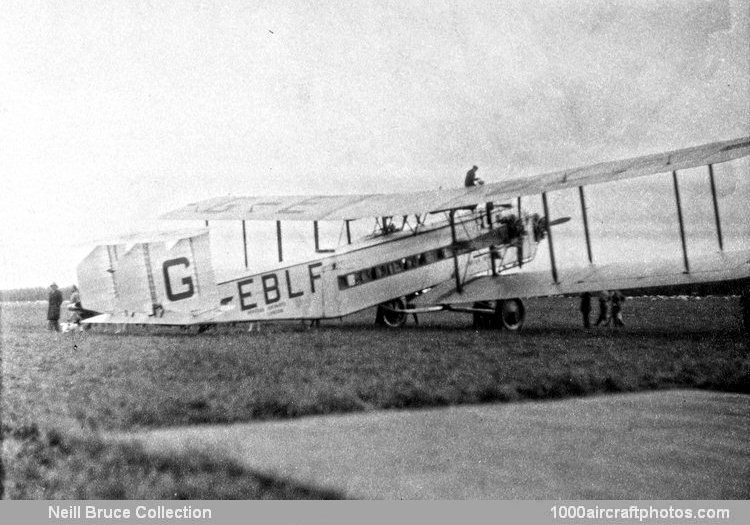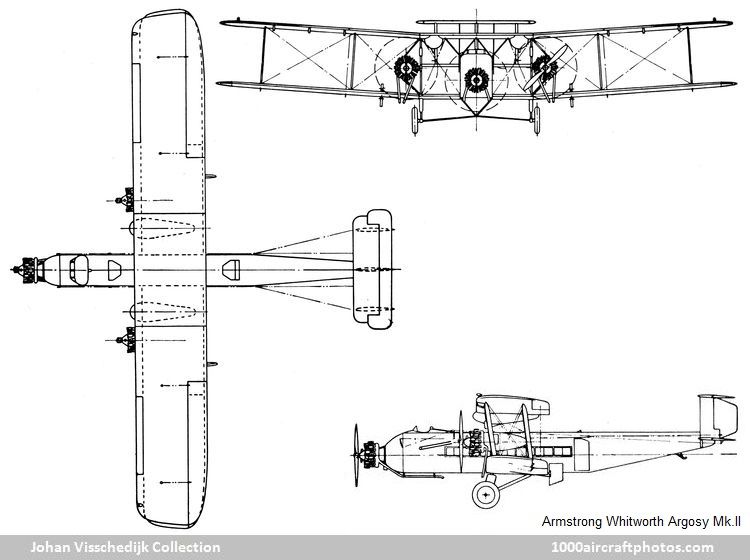07/31/2023. Remarks by Johan Visschedijk: "The Argosy was a large three-engined biplane and, ordered by Imperial Airways of Croydon, Essex, England, the first airliner design produced by the Sir W.G. Armstrong Whitworth Aircraft Ltd. at Parkside, Coventry. It owed a great deal to the Siskin fighter, having a steel tube fuselage, all-steel wings and using the direct-drive 385 hp Armstrong Siddeley Jaguar III Jaguar engine, one of which was mounted in the nose with two others in flat-sided tapering nacelles on the inboard interplane struts. Twenty passengers seated in a long, parallel-sided, square-section fuselage with captain and first officer seated side-by-side in an open cockpit in the nose. Baggage was housed in a special compartment in the tail, reached by a door in the starboard side.
The contract was for three aircraft, the first, registered G-EBLF, making its initial public appearance at the Hendon RAF Display on July 3, 1926. The second Argosy, G-EBLO (c/n A.W.155) and named "City of Birmingham", was delivered to Imperial Airways in the following week and flew the first Argosy service to Paris piloted by the Imperial Airways' Air Superintendent, H.G. Brackley, on August 5, 1926. The prototype was retained for further test flying until delivered to the airline in the following September, the third machine, G-EBOZ (c/n A.W.156) "City of Wellington", arriving in April 1927 after a period under Air Council ownership as a potential troop-carrier. They were put into regular service to Paris, France (2 hr 30 min), Basle, Switzerland (5 hr 45 min), Brussels, Belgium (2 hr 30 min) and Cologne, Germany (4 hr).
Passenger accommodation was much roomier than in any of the airline's earlier aircraft, and on May 1, 1927 G-EBLF left Croydon on the world's first luxury 'named' air route, the London-Paris 'Silver Wing' lunch service. The flagship was on this occasion flown by Capt. G.P. Olley and carried a buffet and steward in place of the two rear seats. Deviations from regular airline schedules were few for these trustworthy aircraft, but on June 15, 1928 G.P. Olley flew G-EBLF from Croydon to Turnhouse, some 6 mls (10 km) west of Edinburgh, Scotland, via the East Coast in a race against the famous steam train 'Flying Scotsman', and won by 15 minutes.
Three additional Argosies, G-AACH to G-AACJ (c/n A.W.362 to A.W.364), were put into service on the European routes in 1929, including the Croydon-Basle stage (later extended to Thessaloniki, Greece) of the newly introduced England-India service. These Argosy Mk.IIs were named "City of Edinburgh", "City of Liverpool" and "City of Manchester" respectively. They were 28-seaters with an improved performance given by 420 hp Jaguar IVA geared radials in Townend rings and were distinguishable from the Mk.I by their Handley Page slots and conical engine nacelles. They also had large vertical servo tabs on the trailing edge of the lower mainplane, which gave finger-light aileron control and automatically applied bank in a flat turn or sideslip, thus relieving pilot fatigue on long journeys. The fleet was joined by the seventh and last Argosy G-AAEJ (c/n A.W.400) named "City of Coventry" on July 9, 1929.
The seven aircraft gave stalwart and uneventful service until 1931, G-AACH being destroyed by fire when crashed at Croydon by a pilot qualifying for a three-engined endorsement. Shortage of aircraft on the South African route in 1930 resulted in the fitting of Jaguar IV As in the older Argosies. G-EBLO and G-EBOZ, were then transferred to Almaza, near Port Elizabeth, the former crashing at Aswan, Egypt, soon afterwards. G-EBLF was rushed to join its fellow, both returning to European duty at the end of the year and finally retired in 1934. G-AACI was lost in a mysterious mid-air fire in Belgium while flying on the Cologne-Croydon route in 1933, and at the end of 1935 the two survivors were also withdrawn from service. British Airways Ltd. acquired G-AACJ and based it at Stanley Park, Blackpool during its last summer, that of 1936, hundreds of joyriders being flown round Blackpool Tower. G-AAEJ was broken up at Croydon, not, it is alleged, without protest, so strong was the structure."

